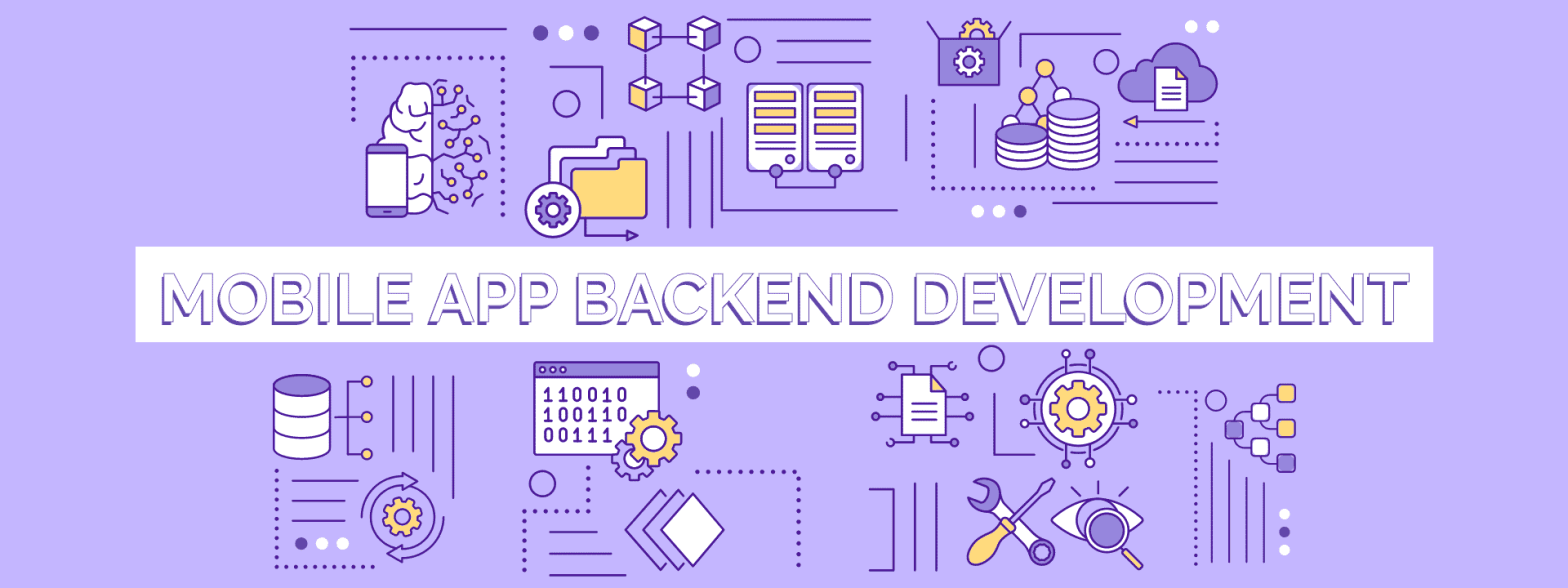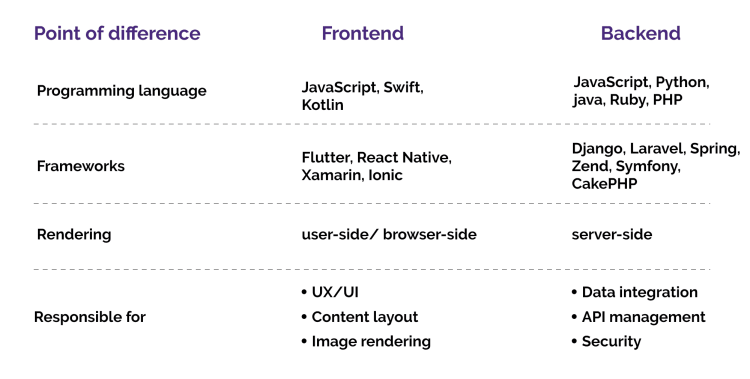
The Only Mobile App Backend Development Guide You Need
![]() Taru M.
Taru M.
Published: 20 Oct, 2022
Like an automobile needs an engine to run, any mobile or web application needs a strong backend infrastructure to function.
If you are a business owner and are planning to build a mobile app to facilitate your services to your consumer, you need to ensure that the mobile app development team adopts the right backend development solutions.
The blog is a crisp guide on mobile app backend development to help you understand what different approaches you can take to build a safe, robust, and scalable architecture for mobile apps.
Table of contents
1. What is Backend in Mobile App Development?
4. Back-End Explained with Example: Payment Processing Algorithm
What is Back-End in Mobile App Development?
Backend, in essence, is a mechanism that handles data storage, business logic, the data access layer of the mobile app, and the server side of the mobile application logic. Development of digital product algorithms, writing APIs, creating libraries, communicating with the database, and configuration of the Operating System and other software components are all part of the mobile app backend services. All these complex processes give life to any application upon which frontend developers and UX/UI designers work to build aesthetic and usable products.
Backend handles all the ‘requests’ the mobile app user makes, be it logging in, ordering, paying, searching, canceling, etc. Therefore, the entire architecture of an app development is contingent on how well the backend is structured and developed.
What is Front-End?
Since we have been discussing Backend Development, it becomes equally important to understand Frontend. If we were to explain Frontend in the most simpler terms, it is the development of the user-side mobile app interface.
Frontend app developers are responsible for the development of the graphical user interface (GUI) of mobile apps. There are many tools, platforms, and programming languages that are used to develop the frontend of the mobile app. For example – Kotlin and Swift are for native mobile apps, whereas many efficient and sophisticated frameworks exist for cross-platform app development – like React Native and Flutter. Options don’t end here, you can use HTML, CSS, and JavaScript to create hybrid mobile apps or Progressive Web Apps(PWA)
Front-End vs. Back-End

Backend Explained with Example: Payment Processing Algorithm
Whenever you buy a product or avail of a service/s online, you must make a payment. The customer enters their payment information (Debit Card/ Credit Card/ Netbanking) in the point-of-sale (or POS). From POS, the information gets transferred to the payment processor via a secured payment gateway which encrypts the customer data. This information might include PAN (Personal Account Number), CVC (Card Verification Code), Card Expiry Data, Consumer’s Name, Contact Information, etc.
All these functions are happening on the user-side of the mobile app, hence the frontend payment processing.
In the backend, the payment processor sends the information to the customer’s card or net banking network, which reaches out to the issuing bank to verify the transaction.
Now, the issuing bank sends the authorization request to the card network. After the card network authorizes the request, the bank sends the verification to the goods and services provider. At last, the POS will tell whether or not the transaction has been successful.
All the transactions are stored in a database (in the backend), so the seller can always access this data, develop algorithms in the backend to analyze the data, and make it accessible by creating a frontend dashboard using UI. Other than this, the backend also enables the implementation of two-step verification which helps in ensuring the transaction takes place in a secure manner.
Many businesses are also using Artificial Intelligence and Machine Learning to develop algorithms in the backend that will enable them to predict the future payment patterns of their customers. AI and ML are also being put to use to develop algorithms to efficiently handle the payment gateway traffic.
If the payment backend algorithm is robust, it will help in
- Preventing fraud
- Conversions
- Billing
- Reducing cost per transaction
Top 3 ways to do Mobile App Backend Development
Mobile app backend service processes are more complex than frontend. Besides, all modern applications require fast and secure communication over servers. Clearly, it is then quite comprehensive, but this doesn’t mean the frontend is easy. Front-end developers work hard to ensure every transition is smooth to alleviate UX.
All the functioning of the backend server is responsible for:
- ensuring the security of the mobile app’s sensitive data and users’ information
- maintaining data stored by the user on the mobile application, either on a remote server or on the cloud
- it enables mobile apps to communicate with other mobile app service providers
- maintenance of business data logic
There are three ways in which a mobile app owner can build backend software for his mobile app:
Mobile Backend as a Service (mBaaS) or Backend as a Service (BaaS)
mBaas is a solution-based software service that facilitates the development of mobile app backends. It enables mobile app owners and developers to link their mobile apps to hardware or cloud-based backend server. BaaS also provides linking to Application Programming Interfaces (APIs) and Software Development Kits (SDKs).
mBaaS is actively becoming the preferable mobile app development because it enables quick delivery of the mobile app, which means the app is out in the market quickly. This is because if you choose Baas, then you just have o connect with the frontend. This reduces mobile app development by half.
Another point worthy of mention here is that if you are still at the beginning of building a mobile app development project and want to build a Minimum Viable Product (MVP) just to test the market waters, then BaaS is your best option, as it will reduce the mobile app launch time.
This will save you time in improving your mobile app based on user feedback. Hence, allowing you to build a more intuitive mobile app using agile methodologies.
Choosing Backend as a Service has another added advantage in terms of the time of backend development. Since, as a digital product owner, you will be outsourcing the maximum of your developmental needs, you will be required to spend lesser amount you would spend developing the backend from scratch. Instead, this time could be used to develop a user-friendly frontend, and create marketing campaigns.
When you go for BaaS, most likely, they will also provide third-party integration services, user authentication mechanisms, social integration, storage, and push notifications as well.
Software as a Service (SaaS)
Software as a service, or SaaS, is a software service model that is subscription-based and has become a very popular business application mode of accessing services via the web.
In essence, it follows a cloud-computing model. Hence, business software and the database get stored in the cloud. In this model, the mobile app owner has to get a monthly subscription to use the backend functionality for their mobile app.
Just like mBaaS, it offers third-party integrations, scalability, easy upgrades, etc. With SaaS, business owners can build best-of-breed solutions.
Well, Gartner lately released its 2022 report on future trends and technology. According to that report, future applications will have modular and composable architecture. And SaaS will help companies to build composable applications using APIs.
Complement with the Future of Mobile Apps. Get to know the latest trends and pivot your mobile apps in that direction for sustainable growth.
Custom Backend Development
Building a mobile backend from scratch gives the most flexibility to the developer as they have the liberty to choose their own tech stack and customize the application as per their needs and requirements.
In custom mobile app backend development, the app owner is not dependent upon the Baas or SaaS service provider. One major downside of being dependent is that a single decision by the software service provider will impact the business tremendously.
Services like Baas or Saas will require the backend mobile app developer to work with a pre-programmed set of programming protocols. But when the mobile app developer develops the mobile backend from scratch. They can be experimentative, which might allow them to come up with unique development solutions.
As your mobile app grows, so will your backend requirement to deal with the increased traffic. In this case, when you use a backend service, you will have to bear the increased pricing of the service provider as well.
In developing a custom mobile app backend, the developer has the flexibility to integrate APIs as per their requirement so that the performance, speed, and response time of the mobile app is always optimized as per the traffic requirements, whereas this flexibility isn’t always available when you rely on the backend as a service.
Some of the most popular mobile app backend development programming languages are
Furthermore, there are many good frameworks built using the above programming languages that help the product ship fast and, at the same time, improve the developer experience.
Every approach has its usefulness. Though we admit more the choices, it becomes difficult to make a decision. We help you to take the best development approach after analyzing your competitors, industries, and your unique business needs. Our backend developers have strong experience in PHP and JavaScript and adapt themselves quickly to a framework. Though, we never depend on one single framework for every project.
Share your project needs with our custom mobile app development company.
Copyright © 2023 NetMaxims Technologies Pvt. Ltd.
All Rights Reserved














